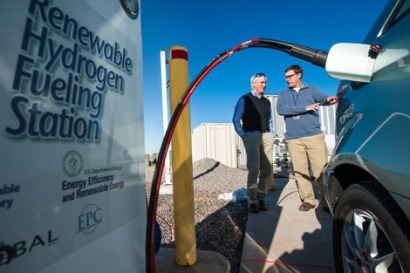
Recent product rollout announcements from auto manufacturers have sparked widespread support and analysis of the hydrogen fuel cell industry. However, renewable hydrogen company HyperSolar has noted uncertainty from the public and private sectors regarding where the hydrogen used to fuel innovative technologies and infrastructure is produced.
The key differentiator in hydrogen fuel production is the source from which it is produced. At present most current and planned hydrogen fuelling stations dispense hydrogen produced from natural gas, known as ‘brown hydrogen’.
However, as with other fossil fuels, natural gas emits carbon dioxide into the atmosphere, and that means hydrogen produced from renewable sources such as wind and solar, known as ‘green hydrogen’, is developed via a much cleaner process in which the only by-product is water. Consequently there is a growing opportunity for renewables-sourced hydrogen production technology, particularly given that in California at least 33 percent of the hydrogen provided at the state’s filling stations must come from renewable sources.
“Recently, countries including the United States, Japan, Denmark, UK, and others continue to push for hydrogen fuel developments, making it crucial for renewable technologies to play a larger role in production, eliminating carbon emissions and providing the market with a cleaner product” said Tim Young, CEO of HyperSolar. “Regulations requiring renewable production provide significant market opportunity for HyperSolar. Our low cost, submersible semiconductor technology does not require any fossil fuel component, making the process truly as ‘green’ as possible. We are confident that our technology is capable of producing renewable hydrogen fuel at or near the point of distribution, and at a cost reasonable enough to ensure industrial scalability.”
HyperSolar, Inc. is the developer of a breakthrough technology to produce renewable hydrogen using sunlight and water. The technology is based on the concept of developing a low-cost, submersible hydrogen production particle that can split water molecules using sunlight without any other external systems or resources – acting as artificial photosynthesis. The company announced earlier this year that it had achieved 1.2 open circuit voltage progressing towards its goal of 1.5 open volts.
For additional information:

